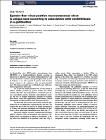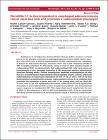Histopathology & Morbid Anatomy: Recent submissions
Now showing items 1-20 of 105
-
A therapeutic roadmap for ovarian cancer using TLR4 MyD88 and MAD2 as prognostic indicators
(Trinity College (Dublin, Ireland). School of Medicine. Discipline of Histopathology & Morbid Anatomy, 2016)Ovarian cancer is 4th leading cause of cancer death in woman and the most lethal gynaecological malignancy. Most patients present with advanced disease where the 5 year survival rate is less than 40%. Standard treatment ... -
Targeting the prostate cancer metabolome with novel trojan horse compounds.
(Trinity College Dublin. School of Medicine. Discipline of Histopathology, 2023)Prostate cancer (PCa) is the second most common cancer diagnosed in males worldwide, and the incidence of this disease is predicted to double globally by 2030. In Ireland, PCa accounts for nearly 16% of all invasive cancers ... -
Corpus of Works submitted for Doctor of Science (Sc.D.)
(Trinity College Dublin. School of Medicine. Discipline of Histopathology, 2023) -
Epstein-Barr virus-positive mucocutaneous ulcer: A unique case occurring in association with cholelithiasis in a gallbladder
(2020)Epstein-Barr virus (EBV)-positive mucocutaneous ulcer is a lymphoproliferative disorder occurring in patients due to iatrogenic or age-related immunosuppression confined to the oropharynx, skin, and gastrointestinal tract. ... -
MicroRNA-17 is downregulated in esophageal adenocarcinoma cancer stem-like cells and promotes a radioresistant phenotype
(2017)Resistance to neoadjuvant chemoradiation therapy (CRT) remains a critical barrier to the effective treatment of esophageal adenocarcinoma (EAC). Cancer stem-like cells (CSCs) are a distinct subpopulation of cells implicated ... -
The role of MyD88 in embryonal carcinoma stem cells
(Trinity College (Dublin, Ireland). School of Medicine. Discipline of Histopathology & Morbid Anatomy, 2015)Tumour-initiating cells are known to share some properties with stem cells. These so called 'Cancer Stem Cells' (CSCs) are highly tumourigenic in the undifferentiated state, a property that is lost upon CSC differentiation. ... -
Investigation of autoantibody profiling to reveal biomarkers of ovarian cancer
(Trinity College (Dublin, Ireland). School of Medicine. Discipline of Histopathology & Morbid Anatomy, 2013)Ovarian cancer is the most deadly gynaecological malignancy and 70% of all women with ovarian cancer die within 5 years of diagnosis. When diagnosed in early stages, ovarian cancer is curable in 90% of cases, however early ... -
Molecular analysis of Human Herpes Virus 8 and associated lesions
(Trinity College (Dublin, Ireland). School of Medicine. Discipline of Histopathology & Morbid Anatomy, 2003)This thesis looks at the bio-pathways of HHV8 through the transformation of endothelial cell lines. This was performed in two separate but mutually contributing experiments. First, endothelial cell lines were infected using ... -
Prognostic markers in thyroid neoplasia
(Trinity College (Dublin, Ireland). School of Medicine. Discipline of Histopathology & Morbid Anatomy, 2000)Prognosis in thyroid carcinoma is usually assessed on the basis of criteria, which include patient age and histological type, grade and stage of tumour. It is well recognised, however, that while occasional tumours with ... -
Molecular characterisation of a new variant of inflammatory bowel disease in children with autism
(Trinity College (Dublin, Ireland). School of Medicine. Discipline of Histopathology & Morbid Anatomy, 2004)A new variant of inflammatory bowel disease, provisionally termed "autistic enterocolitis" has been described in a cohort of children with autistic spectrum disorders. The intestinal pathology includes ileo-colonic ... -
Molecular algorithms in thyroid neoplasia
(Trinity College (Dublin, Ireland). School of Medicine. Discipline of Histopathology & Morbid Anatomy, 2005)Papillary thyroid carcinoma is the most comm on thyroid malignancy, with an incidence of <100 cases per year in Ireland and 16,000 cases per year in the U.S. Incidence is increasing with a global estimate of half a million ... -
Molecular markers in cervical cancer
(Trinity College (Dublin, Ireland). School of Medicine. Discipline of Histopathology & Morbid Anatomy, 2004)Despite the introduction of the Papanicolaou (Pap) test carcinoma of the cervix remains one of the most common malignancies amongst women worldwide. It is hoped that the use of HPV testing and molecular biomarkers in ... -
Genome wide investigation of papillary thyroid carcinoma
(Trinity College (Dublin, Ireland). School of Medicine. Discipline of Histopathology & Morbid Anatomy, 2005)In recent years, there has been a technological explosion in the fields of molecular pathology and molecular oncology. The genome, transcriptome and increasingly the proteome of diverse tumours can now be analysed in minute ... -
C-ABL in human cancer: an investigation of its role in apoptosis inhibition, differentiation and angiogenesis
(Trinity College (Dublin, Ireland). School of Medicine. Discipline of Histopathology & Morbid Anatomy, 2003)Research over the past number of decades has significantly advanced our understanding of the cell signalling effects that mediate a diverse array of cellular activities including cell proliferation, homeostasis and ... -
Molecular Mechanisms of Advanced Prostate Cancer
(Trinity College Dublin. School of Medicine. Discipline of Histopathology, 2018)Globally, prostate cancer is the fourth most common cancer type. Five year survival rates for primary localised disease are high, however these figures decrease significantly with the onset of metastasis. Obesity and ...


















